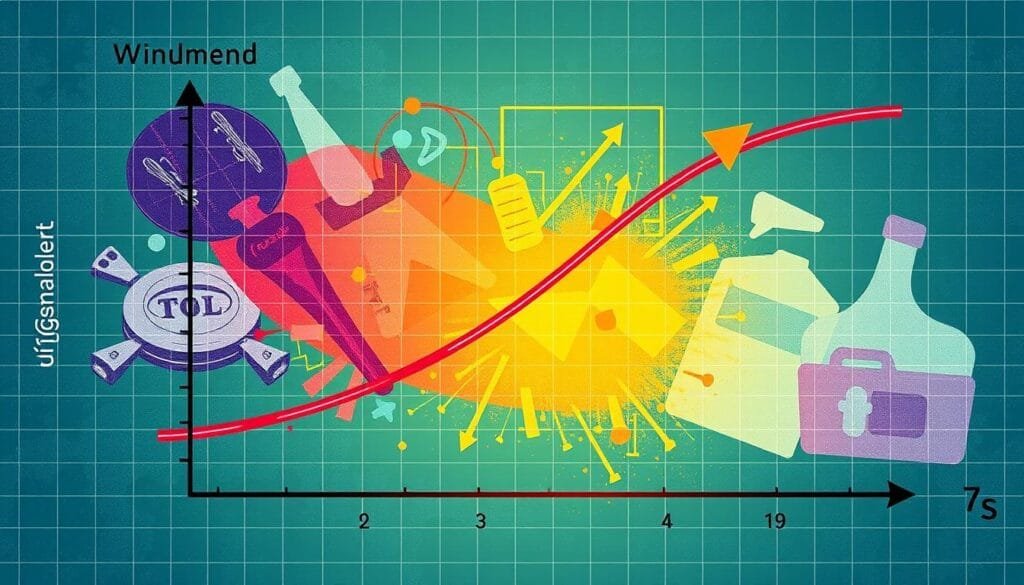Why do we choose some goods over others? How does this choice affect markets? Knowing about demand in economics helps us understand market workings. Prices help decide how much of a product people will buy. Demand means wanting and being willing to buy products at different prices. This price-quantity relationship is key to setting prices and distributing goods.
Demand changes for many reasons. Consumer income, tastes, and other available products can greatly influence consumer buying behavior. For businesses, it’s crucial to grasp these changes. This helps them set the right prices and stock levels.
The demand curve shows price versus quantity demanded. It usually goes down from left to right. This shows that as prices go up, people buy less. When prices drop, they buy more. The law of demand explains this. Still, some exceptions and factors may alter this simple idea.
Businesses that get demand wrong face big problems. Underestimating demand means missing out on sales. Overestimating leads to too much stock. So, knowing about economic demand principles is critical. This knowledge matters for economists and those who make business strategies.
Learning more about these principles uncovers how policies, consumer hopes, and market balance change the economy. For a deep dive into demand in economics, check out our guide. It covers basic terms to how demand works in real life. For more, see our in-depth resource on demand.
Key Takeaways
- The law of demand indicates that when prices rise, the quantity demanded typically falls, and vice versa.
- Various factors, including income, preferences, and substitute goods, affect consumer buying behavior.
- Demand curves slope downward, showcasing the inverse relationship between price and quantity demanded.
- Market equilibrium is achieved at the intersection of supply and demand curves, which can shift based on varying conditions.
- Correctly estimating demand is essential for businesses to avoid lost sales and excess inventory.
What is a Demand in Economics?
Understanding economic demand definition is key to knowing how markets work. It shows the willingness and ability of buyers to get goods and services at various prices. It includes two main aspects: market demand and aggregate demand. Let’s explore these ideas and their main influencers.
Definition and Basic Concept
Demand in economics looks at how the price of an item connects to the amount people want to buy. One vital idea is the elasticity of demand. This concept tells us how demand changes when prices shift. If demand is elastic, a small price rise causes a big drop in demand, mostly when other options are available. But, if demand is inelastic, demand barely changes even with big price increases, usually because there are no substitutes.
Market Demand vs. Aggregate Demand
Market demand is about the total demand for a specific product in a market at different prices. Think of things like Toyota Camrys or Nissan Maximas. Meanwhile, aggregate demand covers all goods and services in an economy. This ranges from household spending to business investments. More income usually increases demand for regular goods but lowers it for inferior ones.
The Role of Consumers and Businesses
Consumers have a big and direct impact in economics. Their buying decisions shape the demand for products at various prices. For example, changes in incomes and tastes can change demand patterns a lot. Meanwhile, businesses affect demand with their pricing, marketing, and supply quantities. They can sway market behavior, influencing the demand for related goods and the balance price where supply meets demand.
“To comprehend how economies function, one must master the intricacies of market and aggregate demand, alongside the pivotal roles consumers and businesses play in shaping these forces.”
Understanding how demand functions in economies helps us foresee how price changes and other factors alter buying patterns. This knowledge guides market trends and economic policy directions.
Determinants and Factors Affecting Demand
Understanding what affects demand is key for businesses and economists. These factors deeply affect how and why people choose to buy things. Let’s look at the main elements that shape demand.
Price of the Product/Service
The product’s price is a big factor in demand. The Law of Demand says if prices go up, people want less, if other things stay the same. Knowing about price changes helps businesses stay on top of the market.
Consumer Income and Preferences
How much money consumers have matters. If people earn more, they usually buy more, unless it’s an inferior good. Then they might choose better items. Also, what consumers like can change demand. Trends and health tips can play roles.

Prices of Substitute Goods
Substitute goods’ prices can change demand too. If a substitute’s price goes up, the main product may see higher demand. Like, if Coke’s price goes up, more might buy Pepsi. This shows in places with close product competitions.
Consumer Expectations and Financing Options
Expectations about future prices or the economy can affect demand now. If people think prices will rise, they may buy sooner. Also, easy financing options can increase demand for pricey items. Like, good home loan terms can boost real estate demand.
Below is a table that summarizes how these factors affect demand:
| Factor | Effect on Demand |
|---|---|
| Price of Product/Service | Inverse relationship; higher prices lead to lower demand |
| Consumer Income | Positive for normal goods, negative for inferior goods |
| Prices of Substitute Goods | Positive relationship; higher substitute prices increase demand for the original |
| Consumer Expectations | Future price increase expectations can raise current demand |
| Financing Options | Easier financing can increase demand for high-priced items |
The Law of Demand and Demand Curve
The law of demand tells us that as prices go up, people want less of something. And if prices go down, they want more. This key idea helps us figure out how markets work. You can see this idea in action on the demand curve, which dips down from the top left to the bottom right.
Understanding the Law of Demand
Every extra item we buy feels less special than the one before. That’s diminishing marginal utility. It explains why we pay less for more of the same thing. For instance, with organic bread priced lower, from $6 to $4, demand jumps from 2000 to 3000 loaves.
Graphical Representation and Demand Curve
The demand curve shows how price and quantity demanded are related. We put price on the vertical line and quantity on the horizontal line in graphs. If the price changes, we move up or down the curve. But if our income or tastes change, the whole curve shifts.
For example, more money usually makes us buy more normal goods. This pushes the demand curve outwards.
“Demand curves show how price and quantity are related. They’re key to understanding what people buy and how markets move.”

Market Equilibrium and Demand Shifts
Market equilibrium is when the amount people want to buy equals what’s available. Changes in what we like, how much we earn, and the cost of other goods can shift demand. This changes the balance. For example:
- More money often means we want more of normal goods.
- Lower prices for things that go together with what we’re buying make us want both more.
- Having similar options can decrease our desire for something.
But, some items are different. With Giffen goods like bread or rice, higher prices actually increase demand because there aren’t good alternatives. Veblen goods, like luxury items, become more desired as they get pricier. This goes against what we usually expect and shows the complex ways market balance and buying habits can change.
Practical Applications of Demand in Economics
Learning about demand’s role in an economy is crucial. It offers insights into large-scale economic policies and everyday business. Grasping the application of demand in the real world lets governments and businesses craft market strategies and economic plans for the best results.

The law of demand shows that price and demand move opposite to each other. As prices go up, the demand often falls, and when prices drop, demand can rise. This key idea helps in designing pricing policies and adjusting production to meet market needs.
The gasoline market serves as a good example:
| Price per Gallon ($) | Quantity Demanded (Million Gallons) | Quantity Supplied (Million Gallons) |
|---|---|---|
| 1.00 | 800 | 500 |
| 1.20 | 700 | 550 |
| 1.40 (Equilibrium Price) | 600 | 600 |
| 1.60 | 550 | 640 |
| 1.80 | 500 | 680 |
| 2.00 | 460 | 700 |
| 2.20 | 420 | 720 |
Looking at the table, we see $1.40 a gallon as the equilibrium price where demand and supply are equal. Price changes lead to either too much product or too much demand.
In economic planning, demand principles help guide big decisions. Governments might cut taxes or spend more to lift demand during tough times. This can help the economy recover faster.
Companies use knowledge about demand to make more money. They set prices by studying demand curves. Knowing what customers want and market trends also helps them plan production and sales.
Even regular people gain from understanding how demand works. It helps them make smarter buying choices and manage their money better.
In a nutshell, demand’s practical uses in economics touch everything. They are key for government decisions, business planning, and smart consumer behavior. All these elements work together to make markets and economies run smoothly.
Conclusion
Understanding demand in economics is key for everyone in the market. This includes consumers, big companies, and governments. They all need to know how demand affects prices and how much of a product is out there.
Recap demand economics shows why it’s important to grasp these ideas in the real world. It helps stakeholders make smarter choices. These choices help improve the economy.
The factors that drive demand include price, how much money people have, and their future expectations. These factors determine how much of a product gets bought and made. For example, when KFC in London dropped their prices, more people bought their food.
Yet, KFC’s experience also teaches that having the right prices isn’t enough. Companies also need to manage their supplies well. This avoids losing chances to sell more.
These economic concepts also tell us about the balance in the market. It covers how demand changes affect what is available and at what price. This balance is crucial for setting policies that make the economy stable and grow.
Understanding demand helps companies know how much to make and how to advertise. It lets them meet what their customers want. This leads to a stronger economy.
FAQ
What is demand in economics?
In economics, demand means when people want to buy things and can pay for them. This idea helps us know how markets work and spread goods around.
What is the difference between market demand and aggregate demand?
Market demand looks at the want for one product in a specific place. Aggregate demand is the total want for all goods and services in an economy. Both are key to study economic movements.
How do businesses influence demand?
Businesses shape demand by pricing and how much they sell. Good pricing and supply choices can change how people buy things and the whole market flow.
What factors affect consumer demand?
Many things impact what people want to buy. This includes prices, income, what people like, other product costs, and thoughts on future prices and loans. These elements change buying desire.
What is the Law of Demand?
The Law of Demand tells us that when prices drop, people want more of that good. And if prices go up, they want less. It’s a basic rule of economics and market study.
How is the demand curve represented graphically?
We show the demand curve going down on a chart. The x-axis shows how much people want, and the y-axis shows prices. It shows how wanting something goes up when prices fall, following the Law of Demand.
What happens at market equilibrium?
Market equilibrium is when buying wants meet selling amounts at a point. Here, price levels may change if demand or supply shifts. This shows how markets balance.
How can understanding demand benefit businesses?
By knowing about demand, businesses can set prices right, forecast market trends, and keep the right stock to make more profit. It helps in making choices that meet market needs.
How does demand impact economic policy-making?
Insights into demand guide governments to impact the economy with policies. They can stabilize the economy, manage inflation, and boost growth by understanding demand shifts.
Why is it important for consumers to understand demand principles?
Knowing about demand helps consumers make smarter buying choices and handle finances well. It lets them see how price changes and economic states affect demand, aiding in budgeting and saving.
